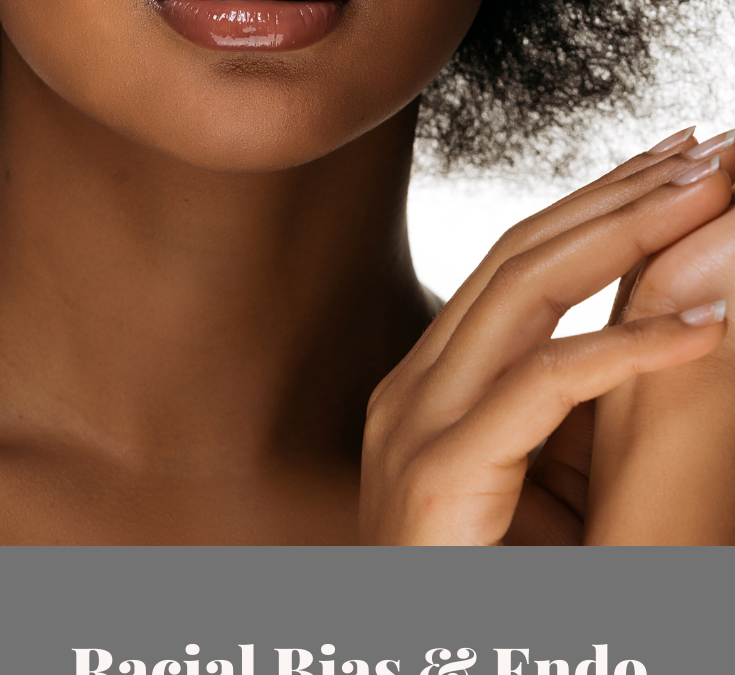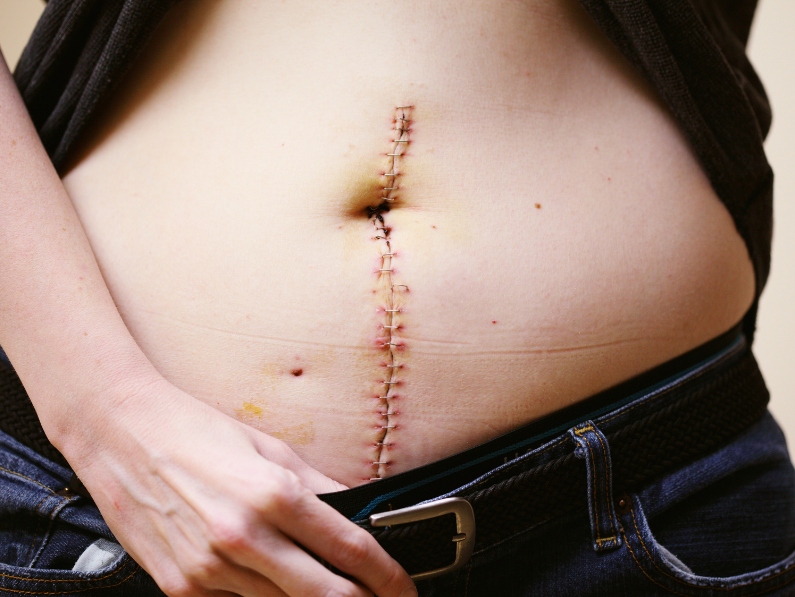Racial bias is an issue that impacts many nuances of our society and world, including diagnosing and treating endometriosis for Black patients. And, while it takes the average endometriosis patient 7-10 years to achieve a proper diagnosis. It can take double the time for Black patients to reach a diagnosis. Multiple factors contribute to the delay of endometriosis, such as the normalization of menstrual pain, lack of awareness surrounding endometriosis, endometriosis sharing similarities with various women’s health conditions, a prolonged diagnostic process, accessibility to standardized care, and implicit bias towards women. However, for Black patients, racial bias is an additional challenge that impacts the diagnostic journey for endometriosis.
Page Contents
Racial Bias Within Modern Medicine
Similar to how racial bias manifests itself in society impacting the treatment of Blacks and minorities. It also exists in the medical world in the form of false beliefs regarding biological differences, stereotypes, and discrimination. Many of these biases originated from pro-slavery advocates in the U.S. during the 1700s and 1800s. The goal was to justify the enslavement and mistreatment of Blacks by proving inferiority and barbarism.
For instance, creating the myth that Blacks have a higher pain threshold, ability to tolerate extreme heat, increased speed, agility, and strength made it easy to classify Blacks as suitable for hard labor and fieldwork. Another myth stated that Blacks have larger reproductive organs that increased fertility, and promiscuity made it easy to normalize breeding Black slaves like cattle.
Yet, these beliefs didn’t change and become an ignorant phase of American history. Instead, it infiltrated society, culture, and medicine to create systemic racism, discrimination, and racial bias. Generations of oppression and White supremacy against Blacks and Black culture have created these issues within society and medicine.
Therefore, contributing to Black endo patients’ struggle and the battle to reach adequate diagnosis and treatment. It limits access to proper endometriosis awareness, education, and treatment for the Black community as a whole.

Racial Bias Impacts How Black Pain is Perceived
Medical professionals often challenge young Black patients seeking resolution for Endo-related pain. In addition to the challenges I mentioned earlier for some physicians, racial bias also clouds judgment preventing proper diagnosis and treatment. Misinformation regarding how Blacks feel pain dates back to slavery and the lie that Blacks are resistant to pain and injury due to a less sensitive nervous system. A lie that was promoted as a fact to justify the validity of the dehumanizing conditions slaves endured.
However, this misinformation still exists in today’s modern society, with many physicians believing this is true. The impact that such a bias creates for Black patients seeking relief for chronic pain means they’re less likely to be taken seriously, and they’re less likely to receive access to prescription medication for pain management. Consequently, this impacts the quality of life and the ability to work and seek gainful employment due to physicians referring to their own biases and perceptions about others’ pain.
Racial Bias Increases Misdiagnosis
Preconceived beliefs regarding Black endo patients increases the risk of misdiagnosis or delayed diagnosis. While common symptoms associated with endometriosis such as chronic pelvic pain, painful intercourse, and painful periods are synonymous with many women’s health disorders. Undergoing a differential diagnosis is a crucial process utilized by doctors to determine the root cause of a person’s pain and symptoms. Furthermore, validating a patient’s pain while working with them to find a solution to manage pain and determine the cause is necessary.
However, the sad reality is that many physicians bypass this approach to differential diagnosis and again rely on biases, personal beliefs, and judgments to cloud decision making regarding diagnosis and treatment. Instead of focusing on the patients’ personal health history, some practitioners make assumptions based on ethnicity, race, and socioeconomic status.
For instance, many Black patients presenting pelvic pain issues, painful periods, and painful intercourse are at a higher risk of being misdiagnosed with pelvic inflammatory disease (PID). While PID and endometriosis share similar symptoms, proper testing for sexually transmitted infections should eliminate it as a reason for those symptoms.
According to Dr. David L. Chatman, a Black gynecologist in the 70s and 80s, racial bias is the main reason for this misdiagnosis. He explained the cause being the fact that myths surrounding the belief non-whites were immune to PID and that Black patients were at an increased risk due to promiscuity. The outcome of this bias led to 40% of Dr. Chatman’s Black patients with endometriosis symptoms misdiagnosed with PID by White physicians.

Racial Bias Influences How Endo Is Researched
Original stereotypes regarding the average Endo-patient involved racial, class, and sexist overtures. In the early 80’s Dr. Veasy Buttram described the career woman being the most likely candidate for developing endometriosis. Characteristics of this woman involved her being a White, well-off, high-achiever focused on her career, which is why she delays childbirth. Such damaging beliefs allow constructs such as race, status, and class to contribute to implicit bias. Therefore, contributing to misdiagnosis and mistreatment.
Furthermore, such beliefs contribute to a lack of representation for Blacks, Hispanics, and other minorities when researching endometriosis. A lack of diversity in research studies fuels the false impression that endometriosis only impacts affluent, childless White women, which is incorrect. Endometriosis symptoms can begin impacting young women of any race after puberty— thus causing symptoms to present during adolescence. Additionally, the lack of minority representation in research allows the myth that biological differences contribute to endometriosis symptoms being different for each racial group.
Racial bias Doesn’t Account for Accessibility to Care
Another struggle Black patients face when seeking proper diagnosis and treatment for endometriosis is access to care. Due to the overwhelming lack of awareness and education about endometriosis, general physicians and gynecologists cannot correctly diagnose and treat it. This means that to treat and manage endo properly, you need to work with someone specializing in endometriosis treatment. This poses a barrier for many Black patients due to the inability to afford specialized treatment, lack of proper insurance coverage, and little knowledge regarding specialists.
For Black patients in lower-income communities, it may be challenging to receive affordable, standard care. Furthermore, these doctors may not have the appropriate tools to diagnose endometriosis, let alone treat it. Additionally, insurance has its own hurdles lack of coverage for medications, surgeries, and therapies means more out of pocket expenses. Mainly, when gold standard endometriosis treatments such as excision surgery and exploratory laparoscopy are not covered, it can be difficult to afford these medical necessities.
Lastly, not understanding that you can receive specialized care for endometriosis treatment contributes to mistreatment. Failure to recognize the many nuances of endometriosis regarding treatment leads to procedures, medications, and therapies administered incorrectly. Thus, physicians need to refer out to specialists equipped with the proper knowledge and tools to diagnose and treat endometriosis. In many cases, doctors either attempt to manage it on their own or completely misdiagnose it and are treating Black endo patients for another condition entirely.
Overcoming Racial Bias in Healthcare
When it comes to increasing awareness of endometriosis and fighting for better-standardized care, we must tackle the multiple factors contributing to delayed diagnosis and inadequate treatment. This includes addressing the racial bias that Black endo patients experience. Because the only way to correct this issue is to discuss the history of racial bias within medicine and its manifesting in the treatment room.
Additionally, removing the prejudice, stereotypes, and barriers that prevent Black patients from accessing the care they need for endometriosis will increase early diagnosis and treatment. Evolving away from the notion that biological differences separate Blacks from Whites is another step towards healing these biases that bar Black patients from receiving the same care as their White counterparts. Moving towards a patient-focused approach to diagnosing and treating endometriosis can decrease racial bias and partiality.
Works Cited
AAMC How we fail black patients in pain written by Janice A. Sabin, PhD, MSW January 6, 2020
The Orlando Sentinel She wants medical world to take endo seriously by Betsy A. Lehman July 19, 1988
About the Author

Hi, my name is Kathleen but you can call me Kat. I’m a health and wellness professional turned freelance writer and content creator. You can find me on YouTube and Instagram. If you take the opportunity to visit me on my other platforms don’t hesitate to leave a message, I would love to hear from you!
Subscribe!
Get updates delivered directly to your inbox!
[gravityform id=”1″ title=”false” description=”true”]






